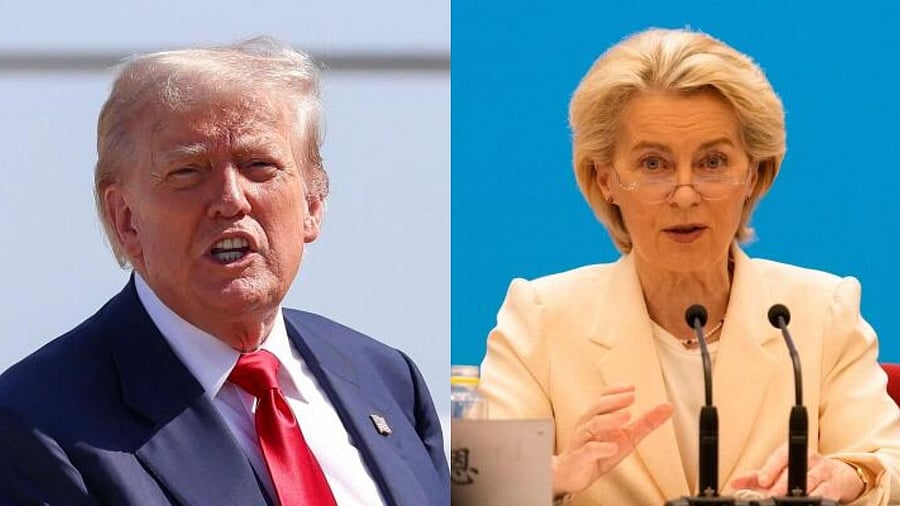
European Commission President Ursula von der Leyen (R) and US President Donald Trump.
Credit: Reuters Photos
Brussels/Edinburgh: European Commission President Ursula von der Leyen is set to meet US President Donald Trump on Sunday to clinch a trade deal for Europe that would likely see a 15 per cent baseline tariff on most EU goods, but end months of uncertainty for EU companies.
Trump, in Scotland for a few days of golfing and bilateral meetings, told reporters upon his arrival on Friday evening that von der Leyen was a highly respected leader and he was looking forward to meeting with her on his golf course in Turnberry.
He said there was a 50-50 chance that the US and the 27-member European Union could reach a framework trade pact, adding that Brussels wanted to "make a deal very badly."
The EU faces US tariffs on more than 70 per cent of its exports, with 50 per cent on steel and aluminium, 25 per cent on cars and car parts and a 10 per cent levy on most other EU goods. Trump has said he would hike the rate to 30 per cent on August 1, a level EU officials said would wipe out whole chunks of transatlantic commerce.
Further tariffs on copper and pharmaceuticals are looming.
A 15 per cent tariff on most EU goods would be seen by many in Europe as a poor outcome compared to the initial European ambition of a zero-for-zero tariff deal on all industrial goods.
But it would be better than 30 per cent and it would remove uncertainty about business conditions that has already hit profits of European companies. For Trump a deal with the EU would be the biggest trade agreement, surpassing the $550 billion accord reached with Japan earlier this week.
Trump, who is seeking to reorder the global economy and reduce decades-old U.S. trade deficits, has so far reeled in agreements with Britain, Japan, Indonesia and Vietnam, although his administration has failed to deliver on a promise of "90 deals in 90 days."
The EU deal would be a huge prize, given that the U.S. and EU are each other's largest trading partners by far and account for a third of global trade.
While close, a deal still requires some final negotiations. U.S. Trade Representative Jamieson Greer and Commerce Secretary Howard Lutnick departed Washington for Scotland on Saturday for talks with EU Trade Commissioner Maros Sefcovic, who is also travelling to Scotland, before the Trump-von der Leyen meeting.
"We're cautiously optimistic that there will be a deal reached," said a Trump administration official, who spoke on he condition of anonymity. "But it's not over till it's over."
In case there is no deal and the U.S. imposes 30 per cent tariffs from August 1, the EU prepared countertariffs on 93 billion euros ($109 billion) of US goods.
EU diplomats have said a possible deal would likely include a broad 15% tariff on EU goods imported into the US, mirroring the US-Japan deal, along with a 50 per cent tariff on European steel and aluminium.
Trump told reporters there was "not a lot" of wiggle room on the 50 per cent tariffs that the US has on steel and aluminium imports, adding, "because if I do it for one, I have to do it for all."
It remains unclear if Washington would exempt EU imports from other sectoral tariffs on automobiles, pharmaceuticals and other goods that have already been announced or are pending although EU officials are hopeful the 15 per cent baseline tariff would apply also to cars and pharmaceuticals.